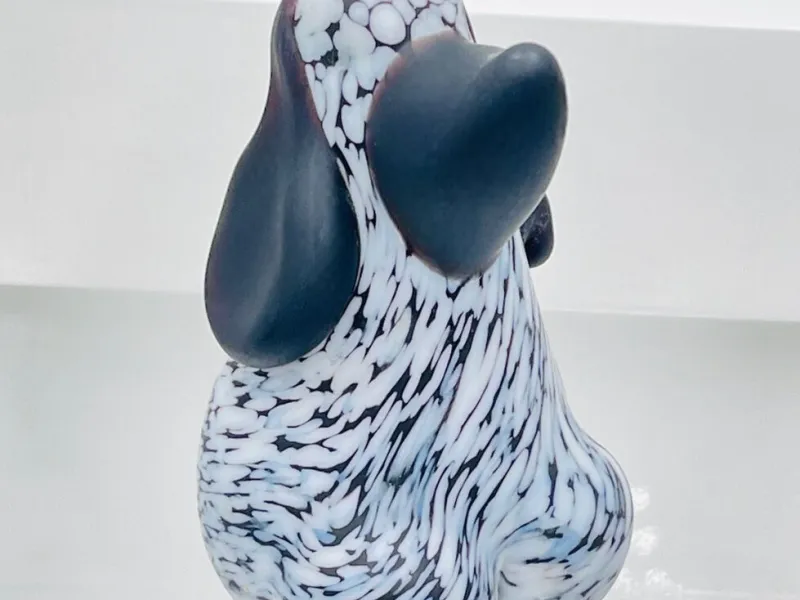
Gaetano Pesce (b.1939 ) is an Italian architect, designer and sculptor. He was born in La Spezia and was professionally active in Padua, Venice, Paris and New York.
Biography
He established an office in Padua, where he became a founding member of Gruppo N in 1959. He experimented with programmed art and collaborated with Gruppo Zero in Germany, Groupe de Recherche d’Art Visuel in Paris (then known as Motus), and Gruppo T in Milan. In favour of Pop art and the kinetic and experimental architecture trends, he rejected the smooth contours of early 1960s Italian design. He began his career at the Hochschule für Gestaltung in Ulm in 1961. He started designing in 1962, experimenting with plastics in 1964, and creating furniture in 1968. His plastics work was first realised in his groundbreaking 1969 UP series of low-cost chairs created by B&B Italia, including the doughnut-shaped UP 5 armchair. The UP 7 was a flesh-coloured model shaped like a giant foot. Pesce produced quilt-draped furniture for Cassina.
Anti-design movement
Along with Ugo La Pietra, he was a member of the Anti-Design movement and was involved in avant-garde groups such as Gruppo Strum and UFO. He realised his work in the fields of sculpture, audiovisual presentations, architecture, and design through kinetic objects, multiples, and serigraphs.

Works
He published Manifesto on Elastic Architecture (1965). Pesce investigated what he saw as the isolation of people and artefacts in consumer culture, drawing attention to it through distortion and exaggeration. He produced nihilistic pieces of ‘decaying’ architecture, among other things. His design work includes;
- the 1971—72 Reconstruction of an Underground City and a Habitat for Two People in an Age of Great Contaminations,
- the 1972—73 Golgotha Set,
- the 1975 Sit Down suite of armchairs,
- The 1980 Sansone tables and the Dalila Uno, Due, and Tre armchairs created by Cassina.
- 1986-89 thermo-formed bottle for Vittel water,
- 1986—88 Unequal Suite of tables and felt armchairs, and 1986 Airport, Square, and Bastone lamps.
- Cassina’s production of his Feltri chair in thick felt and quilted fabric in 1987 took him closer to his goal of producing individualistic and expressive types of architecture furniture. He liked felt because it was inexpensive, recyclable, and appropriate for the developing world.

His unconventional style continued in his 1980 seating for Cassina, Tramonto, and New York (Manhattan Sunrise). A vinyl-upholstered sun rose over foam-covered cushions in a weave reminiscent of houses.
His interior design of photographer and collector Marc-André Hubin’s home on Paris’s Avenue Foch in 1985—86 was widely publicised.
Academia
He was a visiting professor at the School of Architecture in Sao Paulo in 1987. He taught architecture at the Instituto Universitario di Architettura in Venice and Pratt Institute in Brooklyn, New York. Beginning in the late 1970s, he taught at the Ecole d’Architecture in Strasbourg, inspiring a new generation of designers.

Exhibitions
In the late 1950s, he exhibited his work in galleries across Italy. His design work has been widely exhibited worldwide, including one-person exhibits in Bologna, Genoa, Milan, Naples, Rome, Turin, Venice, New York, and the Finnish Design Center in Helsinki. His work was included in the;
- 1970 ‘New Spaces’ exhibition at the Paris Musée des Arts Décoratifs,
- 1970 ‘Modern Chairs 1918-1970’ exhibition at the Whitechapel Gallery in London,
- 1970 ‘Graphics I’ exhibition,
- 1972 ‘Italy: The New Domestic Landscape’ exhibition at the New York Museum of Modern Art,
- 1980 Biennale de Paris, and The exhibitions’ Furniture by Architects’ at the Massachusetts Institute of Technology in 1981,
- ‘Architecture et Industrie’ at the Centre Georges Pompidou in Paris in 1984, and
- ‘Design Since 1945’ at the Philadelphia Museum of Art in 1983—84.
- His work was featured in the 1965 exhibition at the Hochschule für Gestaltung in Ulm,
- the 1965 exhibition at the Finnish Design Center, the 1975 ‘Le futur est peut-être passé’ (‘The Future Might Be Past’) solo exhibition at the Centre de Création Industrielle at the Paris Musée des Arts Décoratifs, and
- the 1975 exhibition at the Centre de Création Industrielle at the Paris Musée des Arts Décoratifs.
- The exhibition ‘Architecture et Design de Gaetano Pesce’ was held at the Montreal Musée des Arts Décoratifs in 1984. ‘
- ‘Gaetano Pesce’ at the Strasbourg Musée d’Art Moderne in 1986,
- ‘Mobili Italiani 1961-1991: Le Varie Eta dei Linguaggi’ exhibition in Milan in 1991,
- ‘Les Annés VIA, 1980—1990’ at the Paris Musée des Arts Décoratifs in 1991, and
- a one-person exhibition at the Peter Joseph Gallery in New York in 1991.
Sources
Byars, M., & Riley, T. (2004). The design encyclopedia. Laurence King Publishing.
Woodham, J. M. (2006). A dictionary of modern design. Oxford University Press.
Additional Reading
Haigney, S., Michals, D. (n.d.). Out in the World with Gaetano Pesce. United States: Literal Matter Incorporated.
Pesce, G., Annicchiarico, S. (2008). Pink Pavillion. Italy: Electa.
Pesce, G., Vanlaethem, F. (1989). Gaetano Pesce: Architecture, Design, Art. Italy: Idea Books.
Webb, M., Bartolucci, M. (2003). Gaetano Pesce. United Kingdom: Chronicle Books.
More on Italian Designers
Related Articles
Discover more from Encyclopedia of Design
Subscribe to get the latest posts sent to your email.





